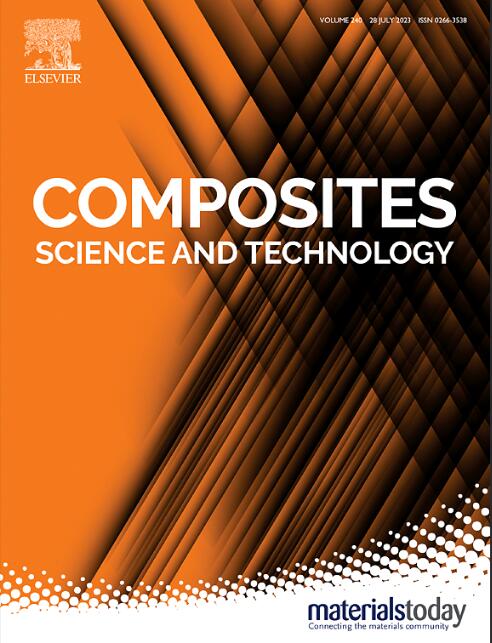Role of the aspect ratio of graphene oxide (GO) on the interface and mechanical properties of vitrimer/GO nanocomposites
IF 8.3
1区 材料科学
Q1 MATERIALS SCIENCE, COMPOSITES
引用次数: 0
Abstract
Epoxy vitrimers are raising an increasing interest for the formulation of multifunctional nanocomposites due to their reversible covalently crosslinked network capable of self-arranging upon stimulation without losing integrity, providing them with new properties such as self-healing or shape memory. The incorporation of functionalized nanomaterials to epoxy vitrimers can further improve and promote those functions, due to the formation of strong reversible vitrimer/nanofiller interfaces. Herein, how the addition of graphene oxide (GO) flakes with different aspect ratios affects such interface, hence the properties, of vitrimer/GO nanocomposites was investigated and compared to those rendered by their epoxy analogues. An evaluation of the nature of the GO/polymers interface performed by Raman spectroscopy confirmed the existence of stronger interfaces between both GOs and the vitrimer relative to the epoxy, which led to better dispersions of the flakes and enhanced mechanical properties, independently of the flakes aspect ratio. Thicker GO flakes were found, however, to render stronger interfaces, hence better mechanical properties, than thinner flakes with higher aspect ratio. The stress-relaxation behaviour of both matrices was found to improve by adding GO materials as fillers, with this result being more pronounced for the vitrimer systems and independent on the aspect ratio of the GO flakes. These findings suggest not only that vitrimer/GO nanocomposites can lead to improved mechanical and stress-relaxation properties relative to their epoxy analogues, but also that selecting a GO with a specific aspect ratio allows the design of nanocomposites with specific structure and mechanical properties through a control of the filler-polymer interface.

氧化石墨烯长径比对玻璃聚合物/氧化石墨烯纳米复合材料界面和力学性能的影响
由于环氧树脂的可逆共价交联网络能够在受到刺激时自排列而不失去完整性,从而为其提供了诸如自修复或形状记忆等新特性,因此,人们对多功能纳米复合材料的配方越来越感兴趣。功能化纳米材料掺入环氧树脂可以进一步改善和促进这些功能,因为形成了强可逆的玻璃聚合物/纳米填料界面。本文研究了不同长宽比氧化石墨烯(GO)薄片的加入如何影响这种界面,从而影响玻璃聚合物/氧化石墨烯纳米复合材料的性能,并将其与环氧类似物进行了比较。通过拉曼光谱对氧化石墨烯/聚合物界面的性质进行了评估,证实了相对于环氧树脂,氧化石墨烯和玻璃聚合物之间存在更强的界面,这导致了更好的薄片分散性和增强的机械性能,而与薄片的长宽比无关。然而,较厚的氧化石墨烯薄片比较薄的高纵横比的薄片具有更强的界面,因此具有更好的机械性能。通过添加氧化石墨烯材料作为填料,两种基质的应力松弛行为都得到了改善,这一结果在玻璃体体系中更为明显,并且与氧化石墨烯薄片的长径比无关。这些发现表明,玻璃聚合物/氧化石墨烯纳米复合材料的机械性能和应力松弛性能优于环氧树脂类似物,而且选择具有特定宽高比的氧化石墨烯可以通过控制填料-聚合物界面来设计具有特定结构和机械性能的纳米复合材料。
本文章由计算机程序翻译,如有差异,请以英文原文为准。
求助全文
约1分钟内获得全文
求助全文
来源期刊

Composites Science and Technology
工程技术-材料科学:复合
CiteScore
16.20
自引率
9.90%
发文量
611
审稿时长
33 days
期刊介绍:
Composites Science and Technology publishes refereed original articles on the fundamental and applied science of engineering composites. The focus of this journal is on polymeric matrix composites with reinforcements/fillers ranging from nano- to macro-scale. CSTE encourages manuscripts reporting unique, innovative contributions to the physics, chemistry, materials science and applied mechanics aspects of advanced composites.
Besides traditional fiber reinforced composites, novel composites with significant potential for engineering applications are encouraged.
 求助内容:
求助内容: 应助结果提醒方式:
应助结果提醒方式:


